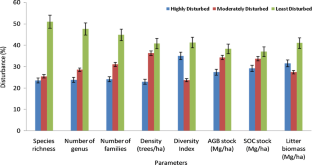Impact of disturbance on vegetation, biomass and carbon stock in tropical forests of Tripura, Northeast India
Research Articles | Published: 24 January, 2020
First Page: 187
Last Page: 193
Views: 3800
Keywords: Biomass, Carbon stock, Disturbance Index, Tripura, Tropical forests
Abstract
In this study, the impact of anthropogenic disturbances on vegetation, soil characteristics, biomass and carbon stock was studied in tropical mixed deciduous forests of Tripura, North-east India. The forests stands were selected based on the presumed disturbance index and categorized in three distinct categories viz. Least Disturbed Forests (LDF), Moderately Disturbed Forests (MDF) and Highly Disturbed Forests (HDF). The study revealed that species diversity is much higher in LDF followed by MDF and HDF sites. Few species like Anogeissus accuminata, Lannea coromandelica, Schima wallichii, and Syzygium cumini are common in all the three categories of forests. The Shannon–Wiener diversity index ranged from 1.32 to 2.51 in all the stands. The phytosociological parameters varied along the disturbance gradient in different stands. The maximum tree density was 198.57 trees ha−1 in LDF, 176.67 trees ha−1 in MDF and least in HDF (111.67 trees ha−1). Soil Organic Carbon (SOC %) recorded maximum in LDF (1.41–1.67%) and minimum in HDF (0.91–1.36%). Tree biomass showed a significant relation with soil organic carbon stock (r = 0.998, p < 0.05). Furthermore, the present study suggests the need for quantification of forest disturbance and biomass which will improve carbon budget estimates and lead to better parameterization of forest carbon cycle models.

References
- Banik B, Deb D, Deb S, Datta BK (2018) Assessment of biomass and carbon stock in sal (Shorea robusta Gaertn.) forests under two management regimes in Tripura, Northeast India. J For Env Sci 34(3):209–223. https://doi.org/10.7747/jfes.2018.34.3.209
- Barbosa JM, Broadbent EN, Bitencourt MD (2014) Remote sensing of aboveground biomass in tropical secondary forests: a review. Int J For Res 2014:1–14
- Bartels SF, Chen HYH, Wulder MA, White JC (2016) Trends in post-disturbance recovery rates of Canada’s forests following wildfire and harvest. For Ecol Manage 361:194–207. https://doi.org/10.1016/j.foreco.2015.11.015
- Behera SK, Sahu N, Mishra AK, Bargali SS, Behera MD, Tuli R (2017) Aboveground biomass and carbon stock assessment in Indian tropical deciduous forest and relationship with stand structural attributes. Ecol Eng 99:513–524. https://doi.org/10.1016/j.ecoleng.2016.11.046
- Bhuyan P, Khan ML, Tripathi RS (2003) Tree diversity and population structure in undisturbed and human impacted stands of tropical wet evergreen forest in Arunachal Pradesh, Eastern Himalayas India. Biodivers Conserv 12:1753–1773
- Brown S, Hall CAS, Knabe W, Raich J, Trexler MC, Woomer P (1993) Tropical forests: their past, present and potential future roles in the world’s carbon budget. Wat Air Soil Pol 70:71–94. https://doi.org/10.1007/BF01104989
- Chambers JQ, Dos Santos J, Ribeiro RJ, Higuchi N (2001) Tree damage, allometric relationships, and above-ground net primary production in central Amazon forest. For Ecol Manage 152:73–84
- Chaturvedi AN (1994) Sequestration of atmospheric carbon in Indian forest. Ambio 23:460–461
- Connell JH (1978) Diversity in tropical rain forests and coral reefs. Science 199:1302–1310
- Curtis JT, McIntosh RP (1950) The interrelations of certain analytic and synthetic Phytosociological characters. Ecol 31:434–455
- Deb D, Deb S, Debbarma J, Datta BK (2016) Tree species richness and carbon stock in Tripura University Campus, Northeast India. J Biod Manag For 5:4. https://doi.org/10.4172/2327-4417.1000167
- Gogoi A, Sahoo UK, Singh SL (2017) Assessment of biomass and total carbon stock in a tropical wet evergreen rainforest of eastern himalaya along a disturbance gradient. J Plant Biol Soil Health 4(1):1–8
- Hegde R, Enters T (2000) Forest products and household economy: a case study from Mudumalai Wildlife Sanctuary, Southern India. Environ Conserv 27:250–259
- Kumar A, Ram J (2005) Anthropogenic disturbances and plant biodiversity in forests of Uttaranchal, central Himalaya. Biod Cons 14:309–331
- Magurran AE (1988) Ecological diversity and its measurements. University Press, Cambridge
- Mishra BP, Tripathi OP, Tripathi RS, Pandey HN (2004) Effects of anthropogenic disturbance on plant diversity and community structure of a sacred grove in Meghalaya, northeast India. Biodivers Conserv 13:421–436
- Mueller-Dombois A, Ellenberg H (1974) Aims and methods of vegetation ecology. Wiley, New York
- Murphy PG, Lugo AE (1986) Ecology of tropical dry forest. Annu Rev Ecol Evol Syst 17:67–88
- Panfil SN, Harvey CA (2015) REDD + and biodiversity conservation: a review of the biodiversity goals, monitoring methods and impacts of 80 REDD + projects. Cons Lett 9:143–150. https://doi.org/10.1111/conl.12188
- Pattanayak SK, Evan Mercer D, Sills E, Yang JC (2003) Taking stock of agroforestry adoption studies. Agrofor Syst 57:173. https://doi.org/10.1023/A:1024809108210
- Pielou EC (1966) The measurement of diversity in different types of biological collections. J Theor Biol 13:131–144
- Rao P, Barik SK, Pandey HN, Tripathi RS (1990) Community composition and tree population structure in a sub-tropical broad-leaved forest along a disturbance gradient. Vegetation 88:151–162
- Shankar U (2001) A case of high tree diversity in a sal (Shorea robusta)-dominated lowland forest of Eastern Himalaya: floristic composition, regeneration and conservation. Curr Sci 81:776–786
- Shannon CE, Wiener W (1963) The mathematical theory of communities. In: University of Illinois press Urbana, pp 111–117
- Simpson EM (1949) Measurement of diversity. Nature 163:688
- Singh SP, Rawat YS, Garkoti SC (1997) Failure of brown oak (Quercus semicarpifolia) to regenerate in the Central Himalaya: a case of environmental semi-surprise. Curr Sci 73:371–374
- Thakur TK, Thakur A (2014) Litterfall patterns of a dry tropical forest ecosystem of Central India. Ecol Environ Cons 20(3):1–4
- Uniyal P, Pokhriyal P, Dasgupta S, Bhatt D, Todaria NP (2010) Plant diversity in two forest types along the disturbance gradient in Dewalgarh watershed, Garhwal Himalaya. Curr Sci 98:938–943
- Walkley A, Black IA (1934) An examination of Degtjareff method for determining soil organic matter and a proposed modification of the chromic acid titration method. Soil Sci 37:29–37
Author Information
Department of Forestry and Biodiversity, Tripura University, Suryamaninagar, India